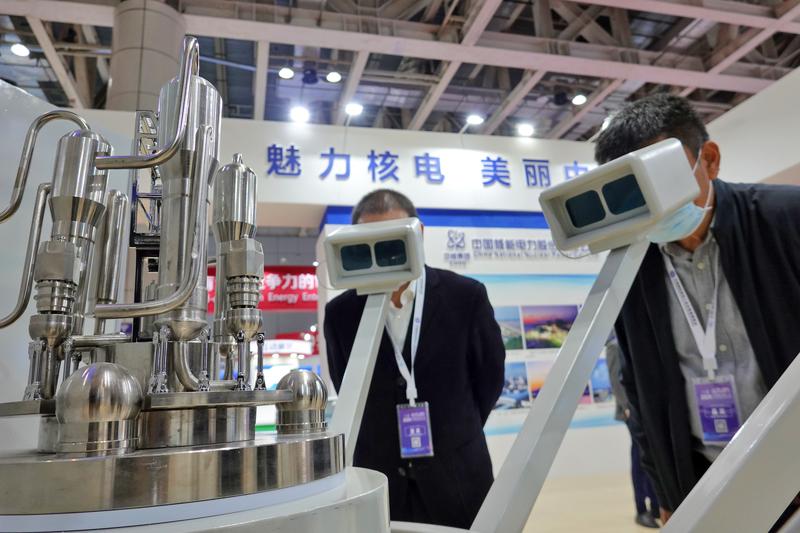 Visitors look at a Hualong One model during an expo in Yantai, Shandong province. (TANG KE / FOR CHINA DAILY)
Visitors look at a Hualong One model during an expo in Yantai, Shandong province. (TANG KE / FOR CHINA DAILY)
More than 10 units of Hualong One, a third-generation nuclear reactor designed and manufactured in China, will be put into operation by the end of 2025, injecting fresh impetus into China's green push, said one of the technology's developers on Thursday.
Yang Changli, chairman of the China General Nuclear Power Corp, said that 11 Hualong One units are under construction in provinces like Guangdong, Zhejiang, Fujian and Hainan.
Unit 3 of the Fangchenggang nuclear power plant in China's Guangxi Zhuang autonomous region, the first Hualong One nuclear unit built in western China, has been connected to the grid for the first time at the beginning of this year. It will be put into operation in the first half of this year, CGN said.
Jointly designed by CGN and China National Nuclear Corp, two Chinese nuclear power giants, the Hualong One pressurized water nuclear reactor is seen as a big step in the development of China's homegrown third-generation nuclear power facilities. It boasts full proprietary intellectual property rights, and its development is said to help China achieve its green goals.
According to CGN, a single Hualong One unit can generate nearly 10 billion kilowatt-hours of electricity per year, which can provide enough electricity to around 1 million people for a year.
By providing clean energy, a single unit can help reduce consumption of over 3 million metric tons of coals and reduce carbon dioxide emissions by 8.28 million tons per year.
Yang said that after more than 40 years of development, China has evolved from a novice to an expert in the global nuclear power industry.
Data from the National Energy Administration showed that 53 nuclear power units, with an installed capacity of 55.57 million kilowatts, are in operation in China, generating electricity that accounts for nearly 5 percent of the total.
In addition, 28 units, with an installed capacity of 32.72 million kW, have been approved for construction, the administration said.
"As a stable and reliable type of clean energy, nuclear power is an important source boosting China's green development. However, safety of nuclear power reactors and adverse impacts once accidents occur still remain key concerns that restrict its wide installation in largely populated cities. Further efforts are still needed to advance technologies in both construction and operation," said Lin Boqiang, head of the China Institute for Studies in Energy Policy at Xiamen University in Fujian province.
According to CGN's head Yang, aside from generating electricity, nuclear energy has broad prospects of development in fields such as heating and hydrogen production.
China has put into operation three nuclear power heating projects. The first nuclear heating project in Northeast China started operations in November last year, serving Hongyanhe township in Dalian, Liaoning province and providing clean heating for nearly 20,000 residents. Shandong Haiyang Nuclear Power Station and Zhejiang Qinshan Nuclear Power Station also started nuclear heating.
Also a member of the National Committee of the Chinese People's Political Consultative Conference, the nation's top political advisory body, Yang submitted a proposal to the CPPCC National Committee that the government should approve more than 10 units of nuclear reactors each year to ensure energy security.


